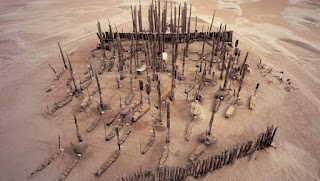THE TARIM MUMMIES
THE TARIM MUMMIES
At the heart of Central Asia lies a shifting sand desert called the Taklamakan, ‘Place of no return’.
It lays within what is called the Tarim Basin, once part of a shallow inland sea that 34 million years ago stretched all the way from the European region north of the Alps. The sea consisted of a series of deep basins connected by shallow seaways, some of which dried up some five million years ago.
The Black Sea, Caspian Sea, Aral Sea, plus Lake Urmia and Lake Namak in Iran are all remnants of this once-vast sea.
Nowadays, the Tarim Basin is flanked by some of the world’s highest mountain ranges, the Kunlun Shan to the south, separating it from Tibet; the Tianshan to the north, separating it from the Mongolian plateau; plus the Himalayas and Pamir mountains to the west, separating it from Tajikistan and the Indian subcontinent.
The area is extremely arid, but the melting snows from the surrounding mountains channel into small rivers whose waters create isolated verdant areas full of life. These river-oases are separated from each other by the forbidding desert, but formed the back-bone of the ancient Silk Road, sneaking from one oasis to the next as it connected China to Central Asia and Europe.
For these reasons the Tarim Basin is one of the most remote and last populated places on Earth. There is no evidence of any permanent settlement during the Paleolithic and Neolithic periods, and the first remains are dated to the Bronze Age some 4000 years ago. These people left behind some amazing burial grounds, and a mystery the archaeogenetists are still trying to solve.
The cemeteries themselves are quite unique, because the people were buried in boat-shaped wooden coffins covered in cowhide with upright head markers in the form of oars – a practice most often associated with the Vikings. Inside the boats are the so-called Tarim Mummies, though they are desiccated corpses whose uncanny state of preservation is not due to any artificial means but to the extreme aridity of the environment and the salinity of the soil.
Many show a mix of non-Asian features, have red or blonde hair which was often infested with lice, are covered in amazing tattoos, and wear dyed woollen fabrics of exceptional beauty. Some burials contained intoxicating substances, pipes, wooden phalluses, fishnets, metal axes, combs, jewellery, and there are mummies with pieces of cheese around their neck, even though none of the analysed DNA shows lactase persistence genes.
Naturally, scientists thought they were the descendants of some Bronze Age Indo-Europeans who had migrated to the region from somewhere else, probably southern Siberia or the mountains of Central Asia.
However, a recent large-scale study of their DNA has revealed that they were a genetically isolated group who descended entirely from Ancient North Eurasians (ANE), a once-widespread Pleistocene population that probably originated in either Europe or the Middle East and was thought to have disappeared after the end of the last ice age about 10,000 years ago.
They spread throughout Eurasia and the Americas in various migrations, and more than half of the world's population today derives between 5 to 40% of their genomes from them. It is proportionally the smallest genetic component everywhere in Europe, never more than 20%, but it is found in nearly every European group and the populations from the Caucasus and Near East.
Interestingly, the most significant ANE ancestry can be found in the indigenous peoples of South America, especially those of the Andean region, while the lowest percentage is found in Eskimos and Alaskan Natives, since these groups migrated into the Americas only roughly 5,000 years ago.
What surprised researchers even more is that even though the Tarim mummies were genetically isolated, they seem to have borrowed some of their traditions and practices from somewhere else. For example, analysis of their teeth showed that the mummies farmed goats and knew how to turn their milk into various dairy products — a process that was likely borrowed from the Afanasievo communities of the Siberian steppe.
Similarly, the mummies were buried with twigs from a certain type of plant, which was a custom found in the Oxus civilization from Central Asia. They wove baskets instead of pottery, and their cuisine revolved around wheat and diary from West Asia, millet from East Asia, and medicinal plants like Ephedra from Central Asia – none of which were indigenous to the Tarim area. Something else which is intriguing are the tattoos, made from charcoal and soot. Some of the mummies are covered with them, showing designs that are similar to other mummies from Russia.
All of which opens more questions, principal among them: what language did these people speak? Some of the evidence seems to indicate that they spoke Tocharian, the second-oldest Indo-European language after Hittite, though the matter is far from resolved.
Since there are many more burial grounds to excavate, all we can do for now is wait and see what new cultural and genetic treasures will be unearthed.
The picture shows an aerial view of the Xiaohe cemetery, also known as the Ördek’s necropolis, courtesy of Wenying Li, Xinjiang Institute of Cultural Relics and Archaeology. It is on the top of a large dune west of Lop Nur, though I couldn’t find it on google maps. You are welcome to scour the surroundings, and if you see anything let me know. https://www.google.com/maps/place/Lop+Nur
If you feel like seeing my own pictures of the Taklamakan Desert, here is a link to the page on my website. I circumvented it in 1995, even though the southern part was closed to foreigners
https://simonettagatto.com/around-the-desert-of-no-return/


.jpg)

.jpeg)






Comments
Post a Comment